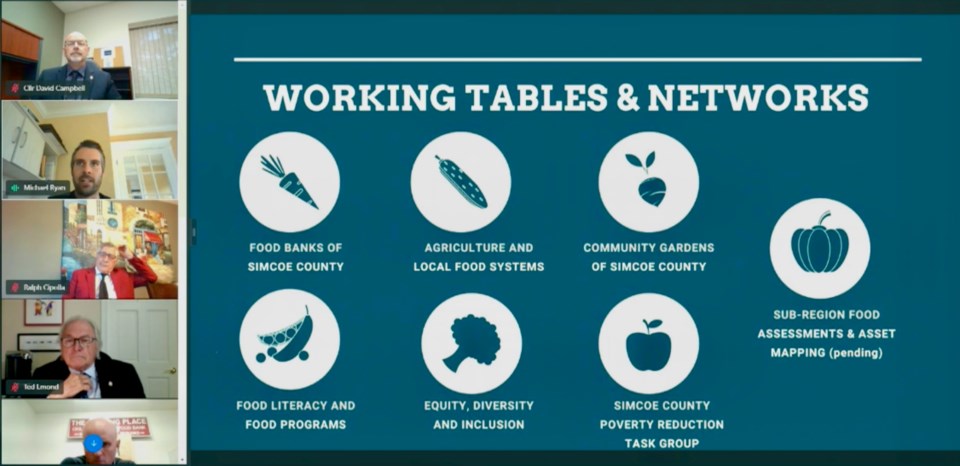A county-wide effort to combat food insecurity is gaining steam, and the city can play a part in bolstering those efforts, council heard Monday.
Michael Ryan, one of the co-ordinators with the Simcoe County Food Council, and Chris Peacock, food council member and executive director of the Sharing Place Food Centre, were on hand to talk about the food council’s work in implementing the Simcoe County Food Security Framework.
In 2013, the Simcoe County Food and Agricultural Charter was adopted
“In 2017, the county felt local food security was something to dive deeper into,” Ryan said.
So, a forum was held, which eventually led to the endorsement of the framework in 2019. It is described as a “blueprint for furthering awareness, co-ordination, and development of approaches designed to enhance food security for all residents in Simcoe County.”
There are six “working tables,” each focusing on a different area, including food banks, community gardens, food literacy, and equity, diversity and inclusion — the latter of which includes representation from those the strategy aims to help.
Peacock, who is also a member of the Orillia food committee, said the food council and its food banks working table have been invaluable to the Sharing Place.
“Before this food council existed, we did not collaborate with local food banks,” he said, noting it has allowed the organization to access grants.
“It has directly affected our bottom line in a positive way.”
The Orillia food committee is a sort of trailblazer as it is one of the only such groups involved with the county food council.
Peacock hopes other municipalities will create similar committees and help to ensure the food council is a success.
“Thank you to city council for supporting the Orillia food committee,” he said. “This has shown great leadership within the County of Simcoe (as an) example of what can be achieved.”
Coun. David Campbell asked how community gardens factor into the county-wide strategy.
“Community gardens, in themselves, are not going to provide enough produce to solve household food insecurity across Simcoe County. They provide important stepping stones, though …” Ryan said, adding food literacy is a major part of the framework.
The city can do its part, Peacock said, by ensuring its bylaws don’t impede efforts to create community gardens and that residents be allowed to do what they can on their own properties to grow food.
Coun. Mason Ainsworth noted many residents have trees that produce fruits such as pears and apples, and he wanted to know how that ties into the overall strategy.
“That’s food that could really help a lot of people that’s just getting wasted,” he said.
About $30 billion worth of food is wasted each year in Canada, Peacock said, calling it “a travesty beyond magnitude.”
He pointed out the Sharing Place has a food-recovery program that sees volunteers collect surplus food from grocery stores and farmers.
In Barrie, there is a program called FruitShare. Volunteers collect fruit that is growing in residential yards and it is split evenly between the property owner, volunteers and organizations such as shelters, the Barrie Food Bank and community kitchens.
That isn’t happening as part of the Simcoe County Food Council’s efforts yet, but it is on the Orillia food committee’s radar, Peacock said.
The food council wants the city to endorse the framework, consider household food insecurity as a priority and “recognize municipalities have a role to play through planning and economic development.”
More information about the Simcoe County Food Council can be found here.
By the numbers
Simcoe County
• 11.4 per cent of Simcoe County residents are living in poverty
• One in eight households (70,000 people) in Simcoe County is food insecure
• Median employment income after tax is $30,951 vs. Ontario: $33,946 (five per cent increase over 15 years)
• In 2016, 46,725 households (25.8 per cent) were spending 30 per cent or more of their household income on shelter costs
Ontario
• 1,719,300 Ontarians live in food-insecure households
• 63 per cent of food-insecure households in Ontario were reliant on wages, salaries or self-employment
Canada
• One in eight (1.8 million) Canadian households is food insecure
• One in six children (1.2 million) in Canada live in food-insecure households
• 11.8 per cent of couples with children younger than 18 were food insecure, but this rate rose to 21.6 per cent for male lone-parent households and 33.1 per cent for female lone-parent households with children younger than 18
• The highest rates of food insecurity were found among households where the respondent identified as Indigenous or Black, at 28.2 per cent and 28.9 per cent, respectively
Sources: County of Simcoe, Simcoe Muskoka District Health Unit, Statistics Canada, University of Toronto





